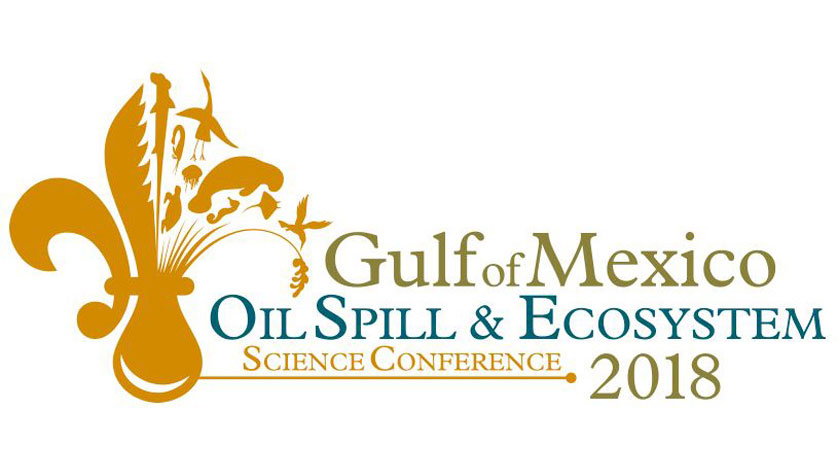2018 Gulf of Mexico Oil Spill & Ecosystem Science Conference (GoMOSES)

Has the Gulf of Mexico recovered following the 2010 oil spill? Has new science made it more resilient to future disasters? Are we now more prepared to respond to the next spill? Experts explore these questions at the upcoming 2018 Gulf of Mexico Oil Spill & Ecosystem Science Conference.
Almost eight years have passed since the Deepwater Horizon oil spill. Join Gulf scientists as they provide updates on fisheries restoration (and their future outlook), explain the latest research on health impacts of the spill, explore how social media helps increase community resilience following disasters, describe new tools to help communities respond to future oil spills, and much more.
The 2018 Gulf of Mexico Oil Spill & Ecosystem Science Conference (GoMOSES) will take place February 5-8 in New Orleans, Louisiana at the Hyatt Regency Hotel. The sixth annual conference, organized by a diverse group of partners, will bring together hundreds of experts from academia, state and federal agencies, non-governmental organizations, and industry to share the latest oil spill and ecosystem scientific discoveries, innovations, technologies, and policies. The conference will include 24 scientific sessions and 7 mini-sessions with 300 oral presentations and 125 poster presentations. For more information view the online program.
Scientific presentations include:
- Restoration Strategies Following Open Ocean Oil Spills: Potential for Stock Enhancement of Apex Pelagic Fish Species.
J. Stieglitz, University of Miami, Miami, FL
Since the 2010 oil spill, though there has been a large focus on the restoration of fisheries stocks in the Gulf of Mexico, little of that has been given to fish stock enhancement of larger, high value fish species such as mahi mahi and tuna. Researchers will discuss the challenges of implementing stock enhancement programs for these fish as well as new strategies made possible by advancements in aquaculture and tracking technology. - A novel material solution to an old problem: Aerogel fabrics for oil capture and recovery
O. Karatum, Exponent Inc., Pasadena, CA
There are many methods to remove oil from the sea surface: you can burn it, break it up with aerial dispersants, or collect it with clothes attached to ship booms. Each method has it costs, benefits, and overall level of efficiency. In the wake of the spill, efforts have focused on new materials to improve the efficiency and economic feasibility of oil collection from the sea surface. Researchers will discuss their exploration of commercially available aerogels to uptake oil, including oil uptake rates, aerogel reusability, and overall oil recoverability rates. - Measuring Social Media Use as a Source of Resilience During and After the Deepwater Horizon Oil Spill
T. Chandler, Columbia University, New York, NY
As with other disasters around the world, individuals and communities experiencing the Deepwater Horizon oil spill used social media to share information and connect with local officials. Researchers will discuss findings from an analysis of over 500,000 Twitter records focused on how communication from the general public was conducted with policymakers, first responders, and public health organizations. Changes in the use of social media over the years following the oil spill will be examined and compared to face-to-face surveys. - Health Risk Assessment of Exposure to Volatile Organic Compounds and Particulate Matter Emitted from Oily Seawater Treated with Dispersant
N. Afshar-Mohajer, Johns Hopkins Bloomberg School of Public Health, Baltimore, MD
After the 2010 oil spill, there was worry over exposure of nearby communities and response workers to airborne toxic compounds from oil on the sea surface, and the application of chemical dispersants added to this concern. Little was known of the effects of surface dispersants on the emission rates of volatile compounds from oil into the air or of potential airborne toxins from the dispersants themselves. Researchers will discuss emission rates of volatile compounds into the air from crude oil, crude oil mixed with dispersants, and dispersant alone.
Other program highlights include:
- Keynote address by Dr. Geraldine Richmond, University of Oregon: “Mulling over Emulsions: Interfacial Molecular Structure and Adsorption at Oil-Water Interfaces”
- Opening plenary panel “The Three R's of Gulf Research: Response, Restoration, and Resilience” will cover the current state of science, how GoMOSES science has contributed to our understanding of the Gulf, and remaining challenges.
- Closing plenary will feature awards for excellence in research and a panel discussion led by Laura Bowie, Executive Director of the Gulf of Mexico Alliance, on the future of the conference.
The registration fee will be waived for credentialed members of the media. Please contact Leslie Smith (lsmith@oceanleadership.org) for details. Onsite registration is available.
GoMOSES is made possible by the generous support of many organizations.

